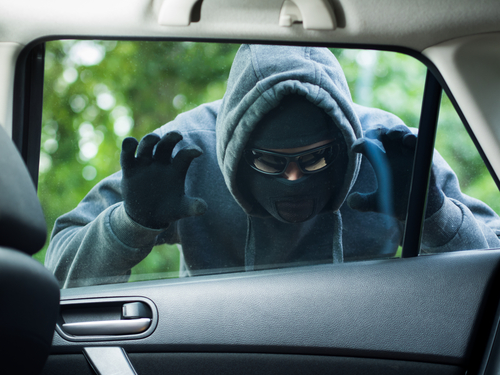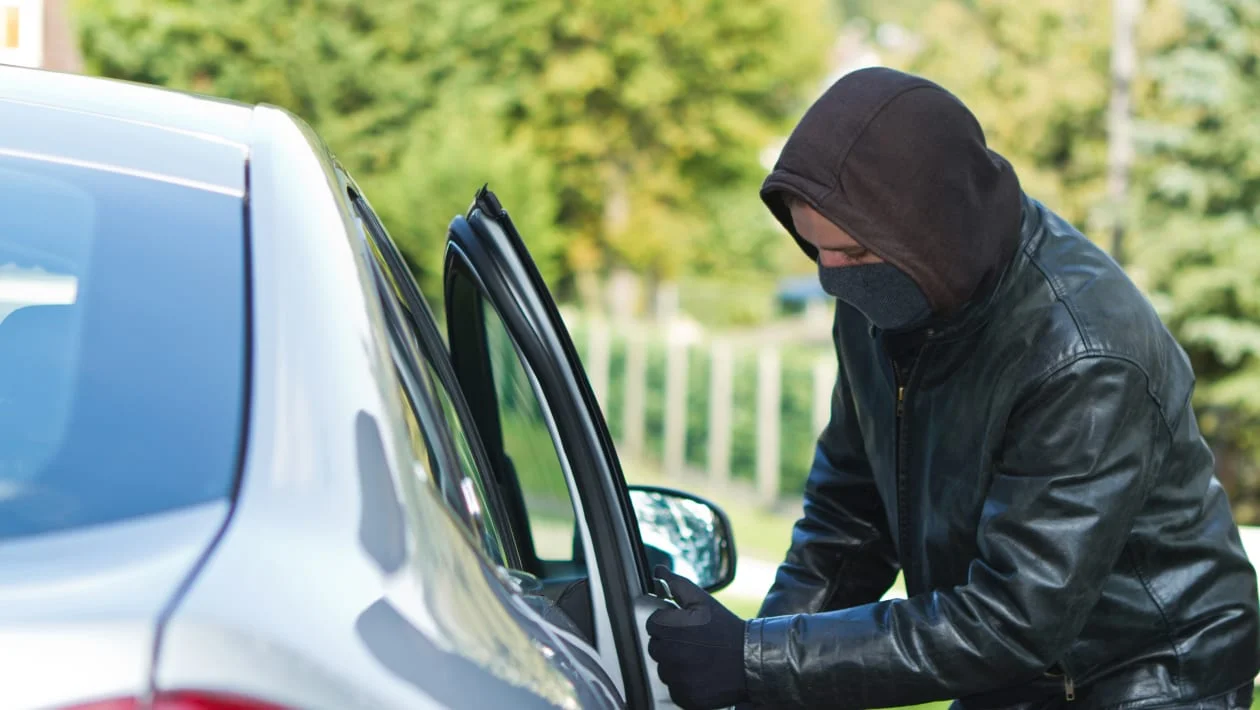One car is stolen every four minutes in France alone. In America, despite a 17% decline in 2024, over 850,000 vehicles still vanished from parking lots, driveways, and streets.
But here's what most owners never realize until it's too late: professional car thieves rarely strike randomly. They scout. They plan. And according to private investigators who've interviewed dozens of convicted criminals, there's one telltale behavior that signals a thief has already marked your vehicle for theft.
They check your mirrors ‼️
Not your rearview mirror or side mirrors in the traditional sense. Thieves are specifically looking at whether your car's electric retractable door mirrors are folded in or extended. It sounds almost comically simple, but this mundane detail has become the automotive equivalent of leaving your front door key under the mat.
The Mirror Trick That's Fooling Everyone
Dr. Keith Floyd, a criminologist at Huddersfield University and former police chief inspector, discovered this pattern while interviewing convicted car thieves in prison. His research, commissioned by Direct Line Insurance, revealed a startling truth: modern criminals use electric wing mirrors as a "green light" system to identify unlocked vehicles.
"With many modern cars nowadays, open door mirrors equate in the thief's mind with an open door," Dr. Floyd explained to The Telegraph.
Here's how it works. Most newer vehicles automatically fold their mirrors when locked. If a thief walks down your street and spots a car with mirrors still extended, they know there's a high probability the vehicle is unlocked. No need to try door handles and risk setting off alarms or attracting attention from passersby.
As one convicted thief told researchers: "I've seen this vehicle quite a number if time" when describing how they identify easy targets. They've made this casual observation into a criminal science.
But the mirror check is more than opportunistic scanning. Some thieves actually adjust mirrors slightly as a marking system, creating subtle signals for their criminal associates. The adjustment might indicate anything from "unlocked vehicle" to "valuables spotted inside" or “easy target confirmed.”
Your First Line of Protection
Window tinting isn't automotive vanity. It's battlefield camouflage for your belongings. When thieves can't see your laptop bag on the passenger seat, your phone charger dangling from the dashboard, or that shopping bag you forgot to remove, your car drops several notches on their target list.
Professional grade tinting creates what security experts call a "psychological deterrent." Thieves are opportunistic predators who want quick, easy scores. When they can't assess the contents of your vehicle in a three-second glance, most move on to easier prey.
But not all tinting is created equal. Standard decorative tint provides privacy but offers minimal protection against smash-and-grab attempts. Security window films, however, add structural reinforcement that can hold shattered glass together even after impact. This gives you precious extra seconds to react and makes the thief's job exponentially harder.
The effectiveness is measurable. According to security specialists, tinted vehicles experience significantly lower break-in rates compared to untinted cars parked in similar locations.
How Signal Jammers Are Changing the Game
Here's where car theft gets genuinely scary. Modern criminals aren't using coat hangers and slim jims anymore. They're deploying military-grade signal jammers that can neutralize your car's GPS tracking system from several meters away.
These pocket-sized devices, available on the dark web for less than $100, create a dead zone around your vehicle. Your factory installed LoJack system? Useless. That expensive aftermarket tracker you installed? Invisible to satellites. Your car essentially disappears from the digital grid while thieves work.
The jamming typically works in a 5-10 meter radius, giving thieves enough operational space to disable tracking devices, override electronic locks, and steal vehicles without immediate detection. By the time the jammer is turned off or moved away, your car could be miles from its original location.
Jenny Sims, the National Police Chiefs' Council's lead on car crime, warns that even the most sophisticated factory security systems become vulnerable when jammers are involved. "Vehicles today are by and large more difficult to steal than ever, unless the thief can access your key or fob to clone them," she noted.
Advanced Protection Strategies That Actually Work
Smart car owners are adapting faster than criminals can evolve. Here's what actually works in 2024:
- Faraday Bags for Key Fobs: These signal-blocking pouches prevent relay attacks where thieves amplify your key fob's signal from inside your house. Keep your keys in one whenever you're home.
- Multiple Tracking Systems: Install both GPS and cellular-based trackers in different locations. If thieves find and disable one, they might miss the backup. Some newer systems even detect jamming attempts and send immediate alerts to your phone.
- Visible Deterrents with Hidden Backup: That steering wheel lock isn't just psychological warfare, it actually forces thieves to spend more time with your vehicle, increasing their exposure risk. But couple it with hidden kill switches or fuel pump disconnects.
- Strategic Parking Intelligence: Park with your mirrors folded in, even in your own driveway. Position your car so the driver's door faces walls or obstacles when possible. Choose spots with natural surveillance, near security cameras, busy walkways, or well-lit areas.
- Digital Hygiene: Never leave documents with your address visible in your car. Thieves often steal vehicles to later burglarize homes, knowing the owners are likely away from their property.
The "Puffing" Problem That's Getting Worse
Winter brings a uniquely American car theft epidemic called “puffing”, leaving vehicles running unattended while they warm up. Thieves literally look for the visible exhaust plumes that signal easy targets.
"I won't bother with cars that require actual work," one convicted thief told researchers. “If it's running and unlocked, I'm in and gone in under 30 seconds.”
The solution isn't suffering through cold mornings. Remote starters allow you to warm your car while keeping it locked and secure. These systems typically cost $200-400 to install but can save you thousands in theft losses and insurance headaches.
What Law Enforcement Won't Tell You
Here's an uncomfortable truth: car theft clearance rates have plummeted 64% since 1964. Today, police solve fewer than one in ten vehicle thefts. You're essentially on your own when it comes to prevention.
But criminals have weaknesses. They hate complications, witnesses, and time delays. Every security layer you add exponentially increases their risk of getting caught.
Consider this: the Chevrolet Camaro ZL1 was America's most stolen car in 2024, with theft rates 39 times higher than average vehicles. Meanwhile, Tesla vehicles remain among the hardest to steal due to their constant network connectivity and remote disabling capabilities.
The difference? Complexity and unpredictability.
Your Action Plan
Check your mirrors, literally and figuratively. Tonight, when you park your car, take five seconds to verify your mirrors have folded in automatically. If they haven't, your locking system might not be engaging properly.
Install window tinting with security film backing. The privacy prevents "window shopping" by thieves, while the reinforcement makes quick smash-and-grab attempts nearly impossible.
Invest in signal blocking key storage and multiple tracking systems. The goal isn't making your car theft-proof, it's making it harder to steal than the one parked next to it.
Remember what that convicted thief said about targeting "lazy" motorists. Don't be lazy. Those five seconds checking your locks and mirrors could save you weeks of insurance paperwork and thousands in losses.
Car thieves are evolving their tactics, but so can you. The mirror trick works both ways, when you understand how criminals think, you can stay one step ahead of them.


Comments (0)
Please login to join the discussion
Be the first to comment on this article!
Share your thoughts and start the discussion